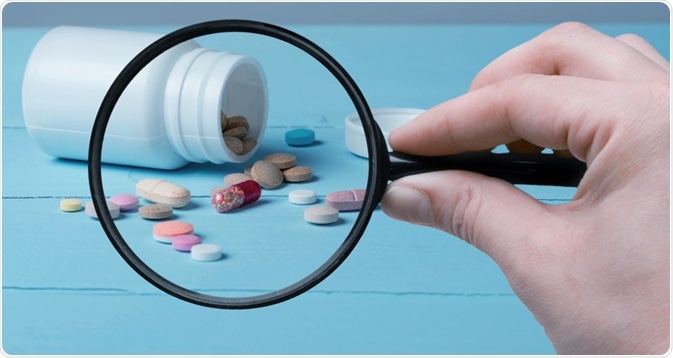Counterfeiting drugs is a major problem in both developed and developing countries. It is prevalent in countries where drug regulation and enforcement are weak. Counterfeit drugs include drugs that either do not have any active ingredients, or have different active ingredients, or active ingredients with different strength compared to authentic drugs.

Counterfeit Drugs. Image Credit: Billion Photos/Shutterstock.com
Impact of Counterfeit Drugs
As these drugs have different concentrations or kinds of active ingredients, they may have differences in quality and efficacy and also may not be safe to use. For example, in one case, the addition of diethylene glycol in counterfeit medicines led to the death of more than 500 people and most of them were children. Diethylene glycol can lead to disorders in the central nervous system, liver, and kidney failure.
In another such case, the sale of placebo pills as contraceptives led to several unplanned pregnancies. Thus, counterfeit drugs can have highly dangerous effects on the health and life of the users and also lessen the confidence of the public in the healthcare industry.
Combatting the Counterfeit Drug Trade: Ashifi Gogo at TEDxBoston
Factors Contributing to Counterfeit Drug Industry
Many factors facilitate the counterfeit drug industry. These include a lack of necessary legislation to regulate the manufacture and sale of drugs. Lack of a legal mandate to license and authorize drugs, labs for analytical testing, distribution of drugs through unlicensed agencies, and lenient penalties for violating the drug regulations can also promote the counterfeit drug industry. Also, when the demand exceeds supply, spurious drug supply may arise to fulfill the demands of the public users.
Tests to Detect Counterfeit Drugs
Thin Layer Chromatography (TLC)
TLC is one of the effective strategies to detect spurious drugs. Using TLC, one can detect substances present in the drug, the content of those substances, and impurities. Many of the drugs contain similar active ingredients but in lower doses. So techniques that only detect the active ingredients and not their levels may give false results.
Analytical Techniques
Advanced analytical techniques may be applied when the counterfeit products are also more sophisticated and require more sensitive tools to detect the active ingredients. These techniques include mass spectrometry, nuclear magnetic resonance, near-infrared spectrophotometer, among others. Techniques involving infrared spectrophotometer are easy to use, do not require a lot of space and sample preparation, and provide results within minutes. It is also portable.
Visual Inspection
Another quick and easy method to detect counterfeit products is a visual inspection. Careful visual inspection and comparison to the original product can be made with respect to the product, packaging, and its labeling. If the packaging, labeling, and physical appearance of the product (shape, size, color) seem different, it may indicate a spurious drug.
If there is no original product to compare, features such as tampered/different packaging and non-uniform coloring of the drug can also indicate that it may be counterfeit. Thus, legitimate manufacturers should provide an accurate description of the physical characteristics of the drug and its material to facilitate the visual assessment.
Implementation of these Tests
WHO provides simple test kits to analyze counterfeit drugs. Proper knowledge and training should be provided for implementing these tests. Methods such as TLC require qualified and expert personnel to perform the tests. Thus, inducting inexperienced personnel to carry out the tests may lead to false-positive or false-negative test results.
Also, as previously mentioned, the information regarding the visual characteristics along with the chemical of each drug should be made available. Also, these guidelines should be translated into local languages to avoid confusion
Further Reading